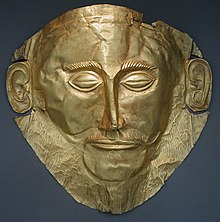Classical Mythology/Euhemerism
 Euhemerus was an ancient Greek who wrote that myths about gods were actually legends about real people from a long forgotten past. A Euhemerist definition of a myth would be:
This interpretation of myth continued into the Christian world, the Middle Ages, and well into the modern period. It is still used today. The excavations of Troy and Mycenae by Heinrich Schliemann were based on the belief that the myths about the Trojan War had a kernel of historical truth in them. Today, scholars still use myths as evidence for ancient societies. For many societies, myths are the main source of literary evidence about their cultures, beliefs, and social systems. In a way, these scholars are using myth texts and artistic representations together with other records to illuminate each other, in a form of New Historicism. Scholars such as Marija Gimbutas have interpreted stories of male gods, such as Zeus or Marduk coming to power after a rule by older female deities, such as Gaia or Tiamat as evidence of an earlier matrilineal, matriarchal culture. Interpreting myths in this manner is essentially historicist, because it argues that the structure of the myths preserve relics of a distantly remembered past.
Theories of Myth Interpretation[edit | edit source]
{==References==
|
}|
